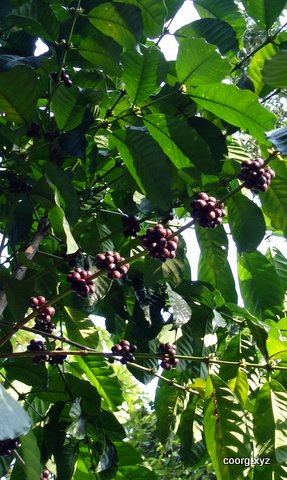Coffee !

Coorg Coffee Beans
Coorg Coffee Beans
W
ell, this is not about coffee making. Rather how coffee produced as a crop product. Many of you heading to Coorg as a tourist probably is going to see for the first time how the coffee is grown.If you think the coffee plantations are going to be filled with that refreshing aroma, you are in for a surprise. And if you think it is not, you are in for a bigger surprise!
Let’s get into a little bit of basics first. You may already know of the coffee plantations of Coorg. Probably what you may not be aware of is that this was the first coffee growing region in the country. And India, the 6th largest coffee producer in the world.
Coorg produces two vanities of coffee – Coffea robusta and Coffea arabica, mostly Coffea robusta though Coorg’s coffee tradition started with introduction of Coffea arabica.
Coffee is a shrubby plant. Means it grows as a bush plant, say about twice your height. What finally makes it into your cup is the seed of the coffee plant, often referred as coffee beans. The pulpy berries ( or cherries ) are plucked and processed. Essentially it is a drying process to remove the pulpy outer layer (drupes).
Growing of coffee plant and its yield greatly depends on many environmental facts. It needs shade, cooler but stable temperature, good fertile land and so on. Regions bordering tropical forests would meet all of these naturally. So is Coorg.
On thing you would notice at a coffee plantation is a variety of taller trees that dots the plantation. The required shade is achieved through the canopy provided by the trees. Traditionally this canopy was provided by the native forest trees, later that got gradually replaced with the inter cropped Mandarins (the type of oranges grown in Coorg). You will also see the canopy provided by more exotic shade trees like Grevillea robusta (Silver Oak ) or Erythrina subumbrans ( Indian Coral Tree ) with its characteristic flame like flowers looming over the plantation.
The later introduction, Coffea arabica, requires lesser shades (and hence more shade trees were cut to give way for denser plantations ), though coffee critiques say it is of inferior quality with respect to Coffea arabica.
Let’s leave the Coffee arabica versus Coffea robusta debate between the environmentalists and the coffee geeks as it is a hotter topic ( than say a cup of coffee!).
Cultivating coffee is a slow and meticulous process. It takes anything up to 7 years for the freshly planted saplings to start giving yield. The life of the plant is more that 50 years. Similarly it takes about 10 months for the flower to turn into berries and finally ripe into the fruit like cherries that are plucked.
Coffee plant with raw coffee berries.
Once it is plucked, it is more of a industry like process till the coffee cherry dried into coffee beans and finally converted into coffee powder. By the way though it is called berry, it is not a berry. And though it is called coffee beans, it is not beans either!
Alright it’s time to reveal the secret. You smelled coffee at Coorg. That was not coming from the plantations, rather from a nearby processing plant or the warehouse that stockpile the coffee merchandise.

Coffee Plant in Coorg
Coorg produces two vanities of coffee – Coffea robusta and Coffea arabica, mostly Coffea robusta though Coorg’s coffee tradition started with introduction of Coffea arabica.
